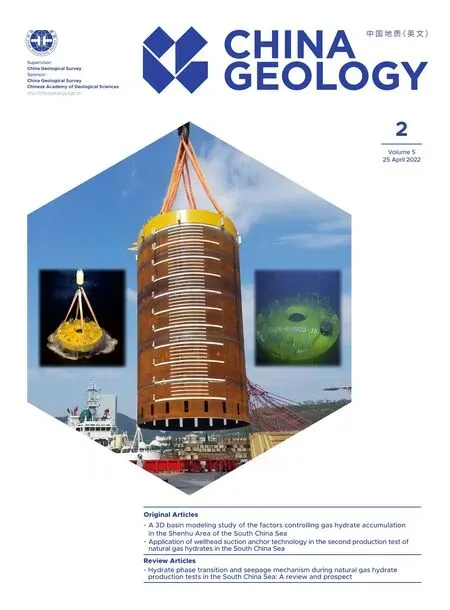A 3D basin modeling study of the factors controlling gas hydrate accumulation in the Shenhu Area of the South China Sea
Zhi-yuan Xi , Jian-gong Wi ,*, Jin-yun Zhng, Zhn Sun , Kun Zhang
a Guangzhou Marine Geological Survey, China Geological Survey, Ministry of Natural Resources, Guangzhou 510760, China
b Southern Marine Science and Engineering Guangdong Laboratory (Guangzhou), Guangzhou 511458, China
c Sanya Institute of South China Sea Geology, Guangzhou Marine Geological Survey, Sanya 572025, China
d China National Offshore Oil Corporation Ltd.-Shenzhen, Shenzhen 518054, China
e Key Laboratory of Ocean and Marginal Sea Geology, South China Sea Institute of Oceanology,Chinese Academy of Sciences,Guangzhou 510301,China
f State Key Laboratory of Marine Geology, School of Ocean and Earth Science, Tongji University, Shanghai 200092, China
Keywords:
3D basin modeling
Gas hydrates
Fault reactivation
Overpressure
Gas seepage
Heat flow
NGHs exploration trial engineering
Oil and gas exploration engineering
Shenhu Area
South China Sea
A B S T R A C T
Great advancement has been made on natural gas hydrates exploration and test production in the northern South China Sea.However, there remains a lot of key questions yet to be resolved, particularly about the mechanisms and the controls of gas hydrates enrichment.Numerical simulaution would play signficant role in addressing these questions.This study focused on the gas hydrate exploration in the Shenhu Area,Northern South China Sea.Based on the newly obtained borehole and multichannel reflection seismic data, the authors conducted an integrated 3D basin modeling study on gas hydrate.The results indicate that the Shenhu Area has favorable conditions for gas hydrate accumulation, such as temperature, pressure,hydrocarbon source, and tectonic setting.Gas hydrates are most concentrated in the Late Miocene strata,particularly in the structual highs between the Baiyun Sag and the Liwan Sag, and area to the south of it.It also proved the existence of overpressure in the main sag of source rocks, which was subject to compaction disequilibrium and hydrocarbon generation.It also shown that the regional fault activity is not conducive to gas hydrate accumulation due to excess gas seepage.The authors conjecture that fault activity may slightly weaken overpressure for the positive effect of hydrocarbon expulsion and areas lacking regional fault activity have better potential.
1.Introduction
Gas hydrates are white crystalline solids formed by natural gas and water under high pressure and lowtemperature conditions (Sloan ED, 2003; Wang JL et al.,2018a; Wei JG et al., 2019).They exist in deep-water areas(300-3000 m below sea level) and the permafrost zone(Kvenvolden K, 1993; Cui YD et al.,2018; Li YL et al.,2021).Gas hydrates have been considered to be a very resourceful fossil fuel (Yang Y et al., 2017; Merey S et al.,2019).Their formation and decomposition may cause submarine landslides and climate change, which has aroused great concern (Brown A et al., 2006; Ruppel CD and Kessle JD, 2017; Zhang K et al., 2020).Moreover, studies on gas hydrates related to cold seeps and bio-geochemical processes have become one of the hottest topics in geoscience (Feng D et al., 2018; Wei JG et al., 2020).
In the last few decades, the Guangzhou Marine Geological Survey (GMGS), China Geological Survey has been dedicated to the exploration of gas hydrates as clean energy,including investigating the favorable conditions for gas hydrates and their abundant resources in the South China Sea(SCS) (Yu XH et al., 2014; Su PB et al., 2021).Traditionally,the exploration of gas hydrates has mainly relied on geophysical methods, such as multichannel seismic and subbottom profiling, to find gas hydrate identification markers,e.g., the bottom simulating reflection (BSR), enhanced reflections, blanking reflections, and gas chimneys (Xu HN et al., 2012; Lee JY et al., 2013; Wang JL et al., 2021).Moreover, logging while drilling (LWD) and pressure coring sampling have been used to study the shape, formation,accumulation, and interstitial water of gas hydrates (Collett T et al., 2012; Wang JL et al., 2018a; Liu LL et al., 2021).Nevertheless, the exploration and drilling of gas hydrates are quite expensive and involve huge risks.The ability to obtain a better prediction before drilling would effectively reduce the risks and costs.
In this paper, the authors propose a new 3D basin modeling method for studying gas hydrate accumulation and apply it in the deep-water Shenhu Area in the northern part of the SCS to analyze the gas hydrate stable zone (GHSZ) and the factors controlling gas hydrate accumulation.The results of this study may benefit future exploration and production.In previous basin modeling studies of gas hydrates, faults were always neglected (Ghori KAR et al., 2005; Kuhn PP et al.,2012; Kroeger KF et al., 2015; Fujii T et al., 2016; Kroeger KF et al., 2019) or were considered to be planar faults, which may not be the actual case (Pi?ero E et al., 2016).Furthermore, sedimentary layers are often considered to be homogeneous, which is also often not realistic (Langhi L et al., 2010; Lampe C et al., 2012).Such simplifications exert a non-negligible effect on the results, and as a consequence,they cannot reflect the migration and accumulation of the hydrocarbons and gas hydrates.In contrast, the authors utilized newly obtained borehole and multichannel reflection seismic data to conduct integrated 3D basin modeling and combined the results with a fault model, which characterizes the sealing and opening caused by fault activity, and detailed heterogeneous sedimentary facies to investigate the gas hydrates in the study area.A fine-scale structural and sedimentary model would allow for more reliable predictions.The factors controlling the gas hydrates, such as the temperature, pressure, and faults were also analyzed.
2.Geological setting
The Shenhu Area is located between the Xisha Trough and the Dongsha Area, with the majority consisting of the Baiyun Sag in the Pearl River Mouth Basin (PRMB) (Fig.1).Under the background of continental rifting and seafloor spreading in the Cenozoic, the Shenhu Area experienced several periods of tectonic movement, including the rifting period, the post-rift thermal subsidence period, and the blocking uplifting period (Pang X et al., 2006; Sun Z et al.,2014).The rifting process continued from the Eocene to the Early Oligocene.The post-rift thermal subsidence period began in the Early Oligocene and ceased around the Late Miocene, which is consistent with the seafloor spreading process.The blocking and uplifting period commenced in the Late Miocene and is still occurring.Correspondingly, three major sedimentary assemblages have been identified, namely the Paleogene terrestrial lacustrine-fluvial facies, the Oligocene transitional-neritic-bathyal facies, and the Neogene abyssal facies, which serve as an excellent petrological assemblage composed of a source reservoir and caps (Pang X et al., 2006, 2007; Liu BJ et al., 2011; Fig.2).In 2007,GMGS successfully cored high saturation gas hydrates for the first time in the Shenhu Area, predominantly consisting of silty clays with the notable occurrence of foraminifera (Su M et al., 2016).According to the sedimentary facies analysis, the Shenhu Area is characterized by draping abyssal sediments,which are accompanied by significant turbidite fans and landslides.The high sedimentation rate and abundant organic matter are advantageous to the formation of gas hydrates.Overall, the Shenhu Area has extraordinarily good hydrocarbon conditions for gas hydrate accumulation (Su PB et al., 2018; Wei JG et al., 2018, 2021).

Fig.1.Geological map of the study area (white rectangle represents the basin modeling area).BYS-Baiyun Sag; LWS-Liwan Sag;NU-Northern Uplift; SU-Southern Uplift; DSR-Dongsha Rise; CSD-Chaoshan Depression; PYLU-Panyu Low Uplift; SHU-Shenhu Uplift;ZHU I D-ZHU I Depression; ZHU II D-ZHU II Depression; ZHU III D-ZHU III Depression.Yellow solid lines represents the seismic lines and the red dotted curve marks the continental-ocean boundary.

Fig.2.The structural sedimentary framework of the Shenhu Area (after Pang X et al., 2007; Xie ZY et al., 2017).L.-Lower; U.-Upper;M.-Middle.
3.Data and methods
In this study, the authors used the PetroMod software to conduct gas hydrate modeling research.PetroMod is an advanced integrated basin modeling system that was developed by Schlumberger and is widely used by Oil&Gas tycoons throughout the world.It combines seismic, well, and geological information to model the evolution of a sedimentary basin.The software predicts if and how a reservoir has been charged in terms of hydrocarbons,including the source and timing of hydrocarbon generation,migration routes, quantities, and hydrocarbon type in the subsurface or at surface conditions.The models are dynamic,which means they provide a complete record of the structural evolution, temperature, and pressure history, as well as the effects on the generation, migration, accumulation, and eventual loss of oil and gas through top seal leakage on geologic time scales.
Structural Model: The China National Offshore Oil Corporation (CNOOC) provided the depths of the 19 main sequences boundaries, including the Seabed, SB5.33, SB10,SB12.5, SB13.82, SB14.78, SB15.97, SB17.25, MFS19.1,SB21.0, SB23.03, ZHSB6, ZHSB5, ZHSB4, ZHSB3, ZHSB2,T70, T80, and Tg (Xie H et al., 2014).These data were used to create a structural model (Fig.3).The entire modeling area was 284 km long and 210 km wide, with 2 km × 2 km grids,and each sequence contained 14910 units.

Fig.3.Structural model, fault model, and facies model of the Shenhu Area (in Fig.a , the deep layers of souce rocks are shown in purple and pink colors, and the overlying sedimentary layers are shown in blue colors; in Fig.b, the northern faults and southern faults are shown in green and pink colors).
Fault Model: Post-rift fault activity has occurred widely in the PRMB (Xie ZY et al., 2017).In the Shenhu Area, there are a series of NWW-trending tensional-shear faults.There are two sets of faults.(1) Major regional faults that deeply cut through the source rock, the reservoir rock, and the strata above.These faults are considered to be beneficial to the migration of thermogenic methane and/or biogenic methane.(2) Small-scale normal faults usually originate from slip faults and polygonal faults.The slip faults were formed by the gravitational sliding blocks extending along the detachment plane and are considered to be preferential pathways for upward methane migration (Su M et al., 2014).The polygonal faults were formed by the contraction of unconsolidated sediments during the dehydration process, and they are characterized by a tensional fault system with a small fault displacement.Vertical or sub-vertical migration of focused fluid provides adequate gas for the generation of gas hydrates(Wang X et al., 2010; Zhang XD et., 2021).
Given the large scale of this research, the authors included the middle-large scale regional faults in this model, but did not consider the slip and polygonal faults.Based on quantitative fault activity analysis, the post-rift faults were divided into three periods: The inherited activation period(23.03-15.97 Ma), the tranquil period (15.97-10 Ma), and the reactivation period (10-2.59 Ma) (Xie ZY et al., 2017).Two main fault zones are recognized in the Shenhu Area.The northern faults are developed along with the Panyu low uplift and the upper slope of the Baiyun Sag, while the southern faults are mostly developed in the southeastern part of the Baiyun Sag (Fig.3b).
Facies Model: According to the drilling research and seismic facies analysis, in the Paleogene, the terrestrial lacustrine-fluvial facies of the Wenchang Formation were developed in a half-graben controlled by its bounding faults,and they gradually transitioned to the extended lacustrine facies in the Enping Formation (Liu BJ et al., 2011).The Baiyun Sag formed in the post-rift period after seafloor spreading, and the original shelf-slope break was located in the southern part of the Baiyun Sag.Thus, a set of neritic shelf delta deposits developed in the main sag and the northern part of the Baiyun Sag.Since the Baiyun movement(about 23.03 Ma), the shelf-slope break has shifted northward into the northern area, and abyssal sediments have been deposited in the main sag.Notably, the fan system was produced during a period of sea-level fall, during which the sediments bypassed the old shelf and slope and were deposited directly into the basin by turbidity processes, and as a result, the primary features in this sedimentary system are a low-stand prograding wedge, a slope fan, and a basin-floor fan (Pang X et al., 2005, 2007).In this study, all of the available borehole data were used to conduct the interpolation of the individual layers.0% ss indicates that there is 0% percent sandstone and 100% silt; 5% ss indicates 5% percent sandstone and 95% percent silt; so forth until 100% ss indicates 100% percent sandstone (Figs.3c, d).The larger the proportion of sandstone, the finer the reservoir will be; and the larger the proportion of silt, the better the sealing ability will be.The terrestrial lacustrine facies of the Wenchang and Enping Formations were considered to be the source rocks due to their higher total organic carbon (TOC) contents.The neritic bathyal silt in the Zhuhai Formation also has a considerable hydrocarbon generation potential.The abyssal silty sediments in the Zhujiang, Hanjiang, Yuehai, and Wanshan Formations were considered to be the major biomethane source rocks.For the bio-geochemical parameters,the authors designate 00% ss, 5% ss, and 10% ss as 1.89%,1.75%, and 1.2% TOC for lacustrine source rocks and 0.35%TOC for abyssal silt (Fu N et al., 2007; Su PB et al., 2011).The kerogen hydrocarbon generation kinetics were based on the Pepper II DE model for Wenchang Formation and Pepper III DE model for Enping Formation (Xie ZY et al., 2015).The biogenic hydrocarbon generation is temperature-dependent and reaches a maximum of 34°C based on the experimental results of GMGS expeditions (Su PB et al., 2018), which is close to the result of previous research (Kroeger KF et al.,2019).
Boundary Conditions: Paleo-water depth and paleo-heat flow are two important boundary conditions.The paleo-water depth affects the analysis of the regional subsidence and the burial history, so developing an accurate method of reconstructing the paleowater depth has always been a problem in geoscience.CNOOC created sedimentary system maps through seismic facies analysis and borehole studies(Xie H et al., 2014).These maps describe the distribution of the paleocoastlines, channels, slope fans, and basin floor fans.They provide an important basis for the quantitative estimation of the paleo-water depth.With the help of drilling data, the paleo-water depth was obtained (Xie H et al., 2014).The heat flow provides the energy for the maturation of the organic matter and is crucial to the analysis of the maturation history.According to the stretch model of the lithosphere(Mckenzie D, 1978), the heat flow in the extensional basin was distinctly higher in the rift period and decreased in the post-rift period.The heat flow in the PRMB is estimated to be 53-87 mW/m2, with an average value of 67 mW/m2(Yuan YS et al., 2009).Shi XB et al.(2017) obtained a heat flow profile of the PRMB transecting the Panyu low uplift, the Baiyun Sag, and the Liwan Sag using borehole temperature measurements andRo constraints.Their results indicate that the heat flow in the Panyu low uplift is relatively low (55-60 mW/m2); the heat flow in the Baiyun Sag gradually increases,with an average value of 70 mW/m2, due to stretching of the lithosphere and asthenospheric upwelling; and the heat flow in the Liwan Sag is extremely high (80-90 mW/m2) due to the effect of the late magmatic intrusion triggered by the contraction of the oceanic crust after seafloor spreading (Wan XL et al., 2019).
4.Modeling results
4.1.Thermal evolution of the organic matter
The Shenhu Area contains three sets of hydrocarbon source rocks: The terrestrial lacustrine facies of the Wenchang and Enping formations, and the neritic bathyal facies of the Zhuhai Formation.The Wenchang and Enping formations are considered to be the primary source rocks due to their large deposition thicknesses and high TOC contents (Pang X et al.,2006; Liu BJ et al., 2011).It is generally believed that the higher basal heat flow may have contributed to the maturation of the organic matter (Shi XB et al., 2017).In this study, four different heat flows (30 mW/m2, 45 mW/m2, 55 mW/m2, and 65 mW/m2) were used in the modeling.The results show that the best-fit heat flow is 55 mW/m2, which is identical to the vitrinite reflectance (Ro) values of boreholes well A and well B (Fig.4).The authors used the best-fit heat flow to analyze the evolution of organic matter.

Fig.4.Ro calibration of the boreholes (the boreholes’ locations are in Fig.1; black dots represent measured vitrinite reflectance, and solid lines denote the model result of vitrinite reflectance).Fm-Formation.
The modeling results show that the Wenchang Formation in the main sag has already entered a period of high maturation and gas generation, with an averageRo of 1.18(Fig.5a).The central main sag area hasRo values of greater than 4.66 and is in the dry gas generation stage.The peripheral area of the main sag hasRo values of 1.0-1.2 and is in the oil generation stage.The northern Panyu low uplift hasRo values of 0.7-1.1 and is also in the oil generation stage.The Liwan Sag is immature, withRo values of 0.29-0.55.Compared with the Wenchang Formation, the maturity of the Enping Formation is relatively low (Fig.5b).Specifically, the main sag area has already entered the medium maturation period of oil and gas generation, with an averageRo of 0.63.The central main sag area hasRo values of greater than 3.42 and is in the dry gas generation stage,whereas the peripheral area of the main sag hasRo values of 0.55 to 1.0 and is in the oil generation stage.The northern Panyu low uplift area hasRo values of 0.55-0.7 and is in the low maturity oil generation stage.The Liwan Sag is immature, withRo values of 0.24-0.55.Compared with the Wenchang and Enping formations, the maturity of the Zhuhai Formation is lower (Figs.5c-h).Specifically, the main sag has already entered the low maturation period of oil generation, with an averageRo value of 0.61.The central main sag area hasRo values of greater than 3.19 and is in the wet gas generation, whereas the margin of the main sag hasRo values of 0.52-0.91 and is in the oil generation stage.The northern Panyu low uplift hasRo values of 0.5-0.69 and is in the low maturity oil generation stage.The Liwan Sag is immature, withRo values of 0.22-0.52.
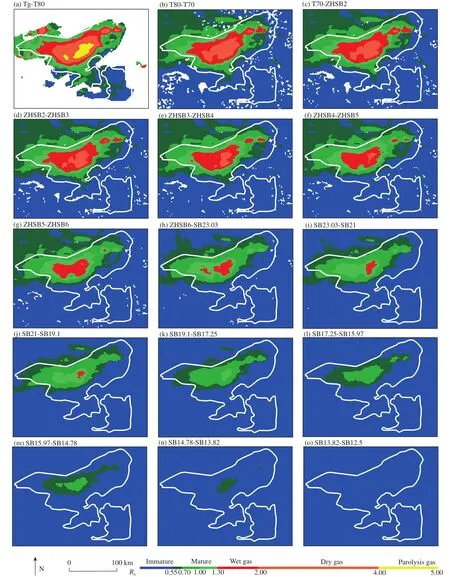
Fig.5.The maturity distribution of the sedimentary units in Shenhu Area, South China Sea.
The maturity of the Zhujiang Formation is relatively low,with an averageRo value of 0.43 (Figs.5i-l), and only the areas in the central part of the main sag and the northern Panyu low uplift are mature.The Hanjiang, Yuehai, and Wanshan formations are immature withRo values of 0.31,0.25, and 0.22, respectively.
In summary, the source rocks of the Wenchang and Enping formations are highly mature, with gas generation in the main sag.The Zhuhai and Zhujiang formations have a medium maturity, with oil generation.The Hanjiang, Yuehai,and Wanshan formations are immature (Figs.5m-o).
4.2.Temperature and pressure in the GHSZ
High pressure and low-temperature conditions are indispensable in the generation of gas hydrates (Collett T et al., 2012).In this basin modeling study, the temperature was subjected to heat flow and the sediment-water interface temperature (SWIT).The authors simulated different heat flows of 30 mW/m2, 45 mW/m2, 55 mW/m2, and 65 mW/m2and the same SWIT of 3.6°C.Fig.6 shows the distribution of the GHSZ under different heat flows.The results indicate that the thickness of the GHSZ is largely affected by the heat flow(Fig.6).A lower heat flow corresponds to a thicker GHSZ,while a higher heat flow corresponds to a thinner GHSZ.The thickness of the GHSZ for 30 mW/m2is distinctly larger than that for 65 mW/m2(Figs.6a, d).This indicates that the thickness of the GHSZ is closely related to the heat flow.The heat flow of 55 mW/m2, which fits theRo value best, was selected as the parameter for the subsequent modeling.
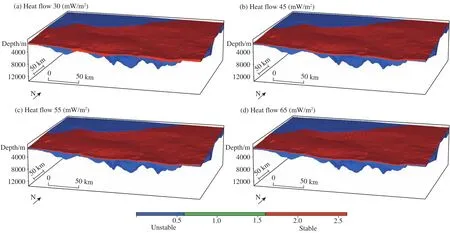
Fig.6.GHSZ distribution under different heat flows.
To investigate the SWIT parameter, the authors set up four different models with SWIT values of 3.6°C, 10°C,15°C, and 20°C, and the same heat flow of 55 mW/m2.The distributions of the GHSZ under the different SWITs are shown in Fig.7.The results indicate that the distribution of the GHSZ is significantly affected by the SWIT.A lower SWIT corresponds to a GHSZ with a wider area, while a higher heat flow corresponds to a GHSZ with a narrower area(Figs.6, 7).The distribution area of the GHSZ at 3.6°C was distinctly larger than that at 20°C (Figs.7a, d).This indicates that the distribution of the GHSZ is closely related to the SWIT.The authors chose the SWIT of 3.6°C to conduct the subsequent modeling.Actually, the seabed temperature decreases with increasing water depth, and it gradually begins to stabilize at 2.2°C when the water depth is over 2800 m.The seabed temperature parameter of 3.6°C was adopted to use in previous studies in the Nankai Trough.
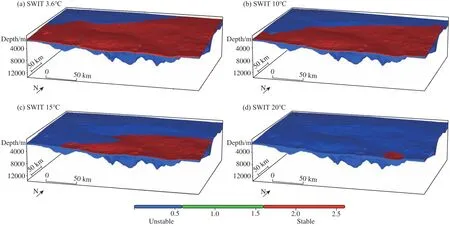
Fig.7.GHSZ distribution under different SWITs.
In the conditions of a heat flow of 55 mW/m2and a SWIT of 3.6°C, the GHSZ gradually pinches out from the shelfslope break to the lower slope along the slope zone of the Shenhu Area (Fig.8).Its thickness around the shelf-slope break is 50-100 m, and its thickness gradually increases to 200-300 m in the deep-water part of the slope.Notably, of all the regions in the Shenhu Area, the GHSZ is the thickest (by 350 m) in the Liwan Sag.
When the temperature is fixed, pressure is another essential factor controlling the thickness of the GHSZ.The pressure is reflected by the variation in water depth.As shown in Fig.8, the water depth is positively correlated with the thickness of the GHSZ.Deeper water corresponds to a thicker GHSZ, while a shallower water depth corresponds to a thinner GHSZ.

Fig.8.GHSZ transect in the Shenhu Area, South China Sea.
The modeling results show that high pressure and lowtemperature conditions are essential to the generation of gas hydrates.They are key factors in controlling the distribution and thickness of the GHSZ.Specifically, the heat flow and bathymetry profoundly influence the thickness of the GHSZ,while the SWIT mainly affects the distribution of the GHSZ.
4.3.Control of faults on the accumulation of gas hydrates
The modeling results show that (1) the main areas for the accumulation of gas hydrates are located in the Liwan Sag and are far away from the fault zone, even though the GHSZ is widespread and coincides with the fault zone macroscopically (Fig.9); (2) the model of the northern faults contains fewer gas hydrates than the model without the faults,and the model with the southern faults has almost the same amount of gas hydrates as the model without the faults (Figs.9, 10).Thus, the authors speculate that these faults have a limited influence on the accumulation of gas hydrates; (3) the eventual amount of gas hydrates in the Shenhu Area calculated for this model using PetroMod is 1140×106t of oil equivalent, and gas hydrate is most concentrated in Late Miocene strata known as Hanjiang Formation and Yuehai Formation.Wanshan Formation also bears considerable gas hydrate accumulation (Fig.10).Furthermore, the authors calculated the total amount of gas hydrates in the SCS to be 66500×106t based on the model of the Shenhu Area.This amount coincides with the estimation of Ge Q et al.(2006)and has the same order of magnitude as Wang JL et al.(2018b).

Fig.9.The relationship between faults and gas hydrate accumulation (upper Hanjiang Formation).

Fig.10.The amount of gas hydrate accumulation in the different layers in Shenhu Area, South China Sea.
4.4.Overpressure evolution
The modeling results proved the existence of overpressure in the main sag of the Baiyun Sag.The results show that overpressure mainly existed in the Wenchang and Enping formations with overlying formations bearing normal hydrostatic pressure (Fig.11).The overpressure commenced at 29.5 Ma and reached two peaks around 23.03 Ma and 10 Ma, then slightly decreased with a relatively steady level,which is similar to the report by Kong LT et al.(2018; Fig.11).The excess hydraulic pressure in the central main sag is 69 MPa and 37 MPa for Wenchang and Enping formations, with the pressure coefficient of 1.8 and 1.6 respectively.Besides,the authors also compared models with different fault properties to research the controls of fault activity on overpressure (Figs.11d, e).All models present an identical trend of overpressure evolution with the pressure coefficient of the model considering fault activity less than the model without faults by 1.2% to the most in the central main sag.
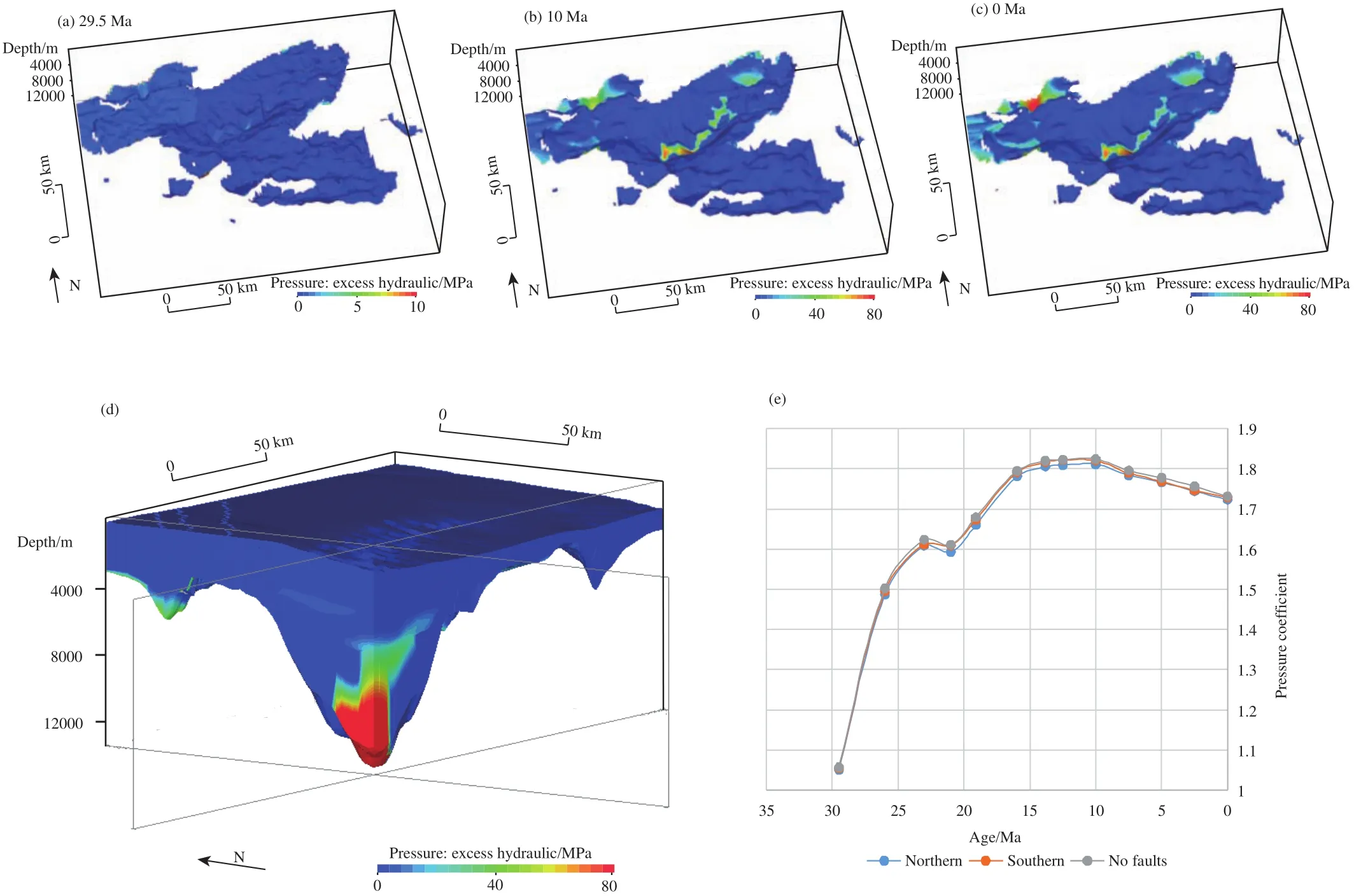
Fig.11.Overpressure evolution in the Shenhu Area, South China Sea.a-c-denote the overpressure distribution in Wenchang Formation in the different historical periods; d-shows the 3D view of overpressure; e-shows the pressure coefficient in the central main sag in Wenchang Formation for different fault models.
4.5.Prediction of favorable drilling dites
The results show that the Liwan Sag and the upper slope of the Baiyun Sag are the two gas hydrate accumulation regions, and the former has more concentrated gas hydrates(Fig.12).Specifically, the uplift zone between the Liwan Sag and the Baiyun Sag and the anticline uplift zone along the southern Liwan sag are considered to be the most promising drilling sites for gas hydrates.The results also show that the gas hydrates are most concentrated at the base of the GHSZ(Fig.12).
The BSR is usually considered to be a significant indicator of the existence of gas hydrates (Hyndman R and Spence G,1992; Collett T et al., 2012; Lee JY et al., 2013).The modeled regions of gas hydrate accumulation coincide with the BSR identified through geophysical exploration (Yu XH et al.,2014).
Based on these modeling results, the authors propose two favorable drilling sites (A and B), which are located in the northern and the southern uplift zone in the Liwan Sag.The average thickness of the GHSZ in these two sites is 280 m.The calculated gas hydrate reserves of the two sites are 33×106t and 74×106t, respectively, which are equivalent to two major oil fields and about half of the crude oil production in China in 2015 (Fig.12).
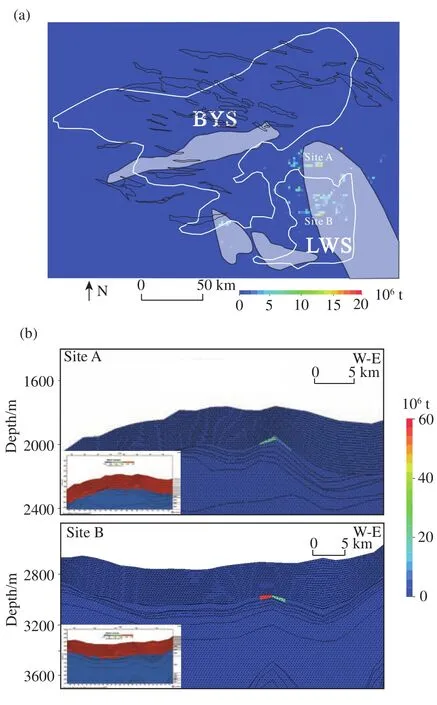
Fig.12.The favorable drilling sites in Shenhu Area, South China Sea.The area in light grey color represents the BSR by Yu XH et al.(2014) in Fig.a.
5.Discussion
5.1.The controls of heat flow disparity
Fujii T et al.(2016) found that the modeled heat flow value of 30 mW/m2is lower than the measured heat flow value of 45 mW/m2in the Nankai Trough.Guterhuber J et al.(2016) also found that the modeled heat flow values of 41-60 mW/m2are lower than that in the Eastern Alps Molasse Basin.It should be noted that this is not a unique phenomenon.The fast-sedimentation rate would destroy the thermal equilibrium of the sedimentary layers (Harris R et al.,2013).The seabed’s topography also affects the thermal structure (Li H et al., 2014).The Shenhu Area is characterized by fast post-rifting sedimentation (Zhao ZX et al.,2010), and the average deviation of 15 mW/m2is similar to those reported by Fujii T et al.(2016) and Gusterhuber J et al.(2014).Thus, the authors used 55 mW/m2as the modeled heat flow value, which is lower than the average measured heat flow value of 70 mW/m2.
5.2.The role of fault in the migration and accumulation of gas hydrate
The modeling results indicate that regional fault activity is unfavorable for the accumulation of gas hydrates, which is supported by the decreasing amount of gas hydrates, and it is most significant for the model including the northern faults(Fig.10).The authors speculate that the control of the regional faults on the gas hydrate accumulation is reflected in the amount of biogenic gas that migrates from the Baiyun Sag to the Liwan Sag, as sedimentary strata in Liwan Sag have larger porosity than the Baiyun Sag for its less compaction and burial depth (Fig.13).When the fault activation is strong in the Baiyun Sag, it contributes to the repulsion of biogenic gas, as it does with the repulsion from the source rock.Moreover, this may result in the seepage of biogenic gas into pockmarks and gas plumes (Judd A and Hovland M, 2007).These two effects control the amount of gas hydrate accumulation.Previous studies have identified possible gas plumes on acoustic images of the water (Xu HN et al., 2012)and methane seepage was observed in the Shenhu Area (Guan HX et al., 2016; Qiu ZY et al., 2018).The modeling results show that the amount of seepage is larger than the amount of repulsion during fault activation.The overall effect is a reduction in the amount of biogenic gas, which could migrate into the Liwan Sag (Fig.13), leading to a reduction in the gas hydrate accumulation in the Liwan Sag.
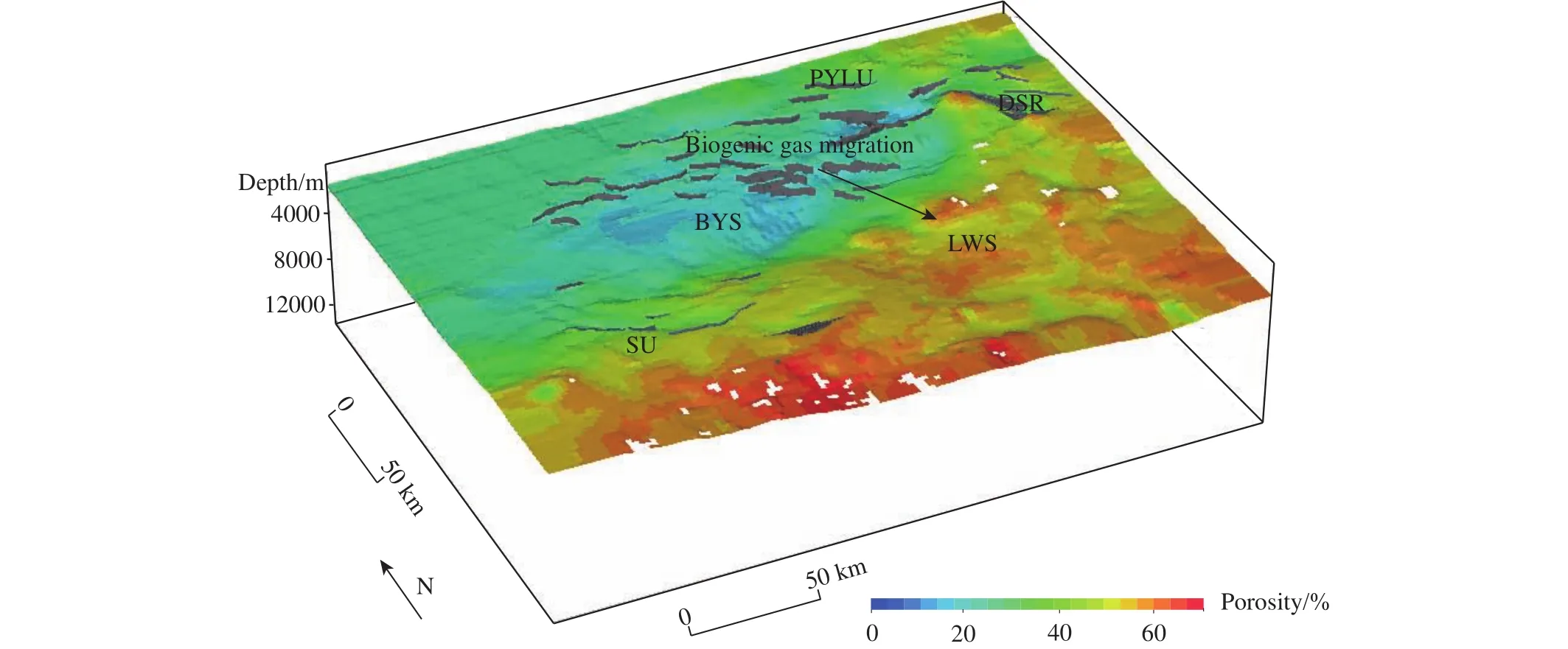
Fig.13.Schematic of biogenic gas migration in the Shenhu Area, South China Sea.The base map shows the porosity of the upper Hanjiang Formation (SB13.82-SB12.50), and faults are shown in grey polylines.BYS-Baiyun Sag; LWS-Liwan Sag; SU-Southern Uplift; DSR-Dongsha Rise.
It should be emphasized that the inherent relationship between the faults and the gas hydrates is complicated.Current theories support these two aspects, i.e., the migration pathway and reservoir (Cook AE et al., 2008; Riedel M et al.,2010).Because of the limited amount of data, it considered a fault to be a plane rather than a crushed zone (Brogi A, 2008),which would act as an excellent pathway for fluid migration and gas hydrate accommodation.Therefore, research into the microstructure of these faults needs to be conducted.
5.3.The control of fault activity on overpressure
The compaction disequilibrium aroused from rapid sediment deposition is generally considered one of the most important mechanisms for overpressure generation (Magara K, 1978; Swarbrick RE and Osborne MJ, 1998).In addition,hydrocarbon generation is another non-negligible mechanism for overpressure generation (Swarbrick RE et al., 2002; Kong LT et al., 2018).It should be noteworthy that the overpressure of this model with fault activity is only slightly less than the model without considering fault activity (Fig.11).The authors inferred that this may be related to the increase of hydrocarbon expulsion due to fault activity, thus attenuating overpressure generation.
Besides, all these models show that overpressure evolved with two peaks (23.03 Ma and 10 Ma) and gradually decreased since 10 Ma.The trend of overpressure evolution is identical to each other for models with fault activity and without faults (Fig.11).Kong LT et al.(2018) suggested that the Baiyun and Dongsha events account for the release of overpressure in the model.However, the authors conjectured that the evolution of overpressure could be mainly attributed to the internal mechanism by compaction disequilibrium and hydrocarbon generation, and fault activity could exert limited influence on overpressure evolution.
5.4.The tectonic control of gas hydrate accumulation
the migration and accumulation simulation results indicate that the gas hydrate mainly accumulates at structural highs(Fig.12).In 2017, China’s first field offshore hydrate production test in the Shenhu Sea 2017 reached a total gas production of 309000 m3for 60 days with average daily gas production of 5150 m3(Li JF et al., 2018; Shaibu R et al.,2021).The testing site and well A are close together.In addition, well A was located at the structural high of a submarine ridge, which was favorable for the accumulation of gas with the cap of the overlapping layers (Fig.14).The gas hydrate formed within the GHSZ under the interaction of temperature, pressure, gas, and interstitial water.

Fig.14.Interpreted seismic profiles along with L1 and L2 (L1 and L2 are shown in Fig.1).Horizontal lines represent identified seismic sequences, and red inclined lines represent identified faults.
Furthermore, a tectonic stress regime may exert a positive effect on the migration and accumulation of gas hydrate.In the Late Miocene, the Dongsha Event influenced the northern South China Sea from east to west by plate bending resulting from the subduction and collision of the South China Sea toward the Philippine Sea Plate (Wu SG et al., 2014; Xie ZY et al., 2017).Thus, a fluid potential difference formed between the transpressional deep blocks and transtensional upper sedimentary layers, which was favorable for the migration of gas and focused fluid flow.
6.Conclusion
In this study, the authors created an integrated 3D basin model of the Shenhu Area of the PRMB, which revealed that this area has favorable conditions for gas hydrate accumulation.In the modeling, the authors created a refined facies model and fault model, which has rarely been done in previous studies.The modeling results indicate that the GHSZ is mainly affected by temperature and pressure.The heat flow and water depth largely control the thickness of the GHSZ.The SWIT profoundly affects the distribution of the GHSZ.Gas hydrate is most concentrated in the Late Miocene strata,such as Hanjiang Formation, Yuehai Formation, and Pliocene Wanshan Formation.The overpressure evolution could be mainly attributed to the internal mechanism by compaction disequilibrium and hydrocarbon generation, and fault activity could exert limited influence on overpressure evolution.The negative effect of the regional fault activity on the gas hydrate accumulation may be related to the excess seepage of biogenic gas.The favorable gas hydrate accumulation zones are mainly at structural highs most concentrated between the Baiyun sag and Liwan Sag, and the area to the south of it.The Dongsha Event may exert a positive effect on the migration and accumulation of gas hydrate.
CRrediT authorship contribution statement
Zhi-yuan Xie conceived of the presented idea and prepared the original manuscript.Jian-gong Wei undertook writing reviewing and editing.Jin-yun Zheng provided seismic data and drilling data for this study.Zhi-yuan Xie,Zhen Sun, and Kun Zhang carried out the analysis of modeling result.All authors discussed the results and contributed to the final manuscript.
Declaration of competing interest
The authors declare no conflicts of interest.
Acknowledgment
This study was funded by Key Special Project for Introduced Talents Team of Southern Marine Science and Engineering Guangdong Laboratory (Guangzhou)(GML2019ZD0201, GML2019ZD0104), and Finance Science and Technology Project of Hainan Province (ZDKJ202019).
- China Geology的其它文章
- Exploring natural gas hydrates toward a carbon-neutral world
- Hydrate phase transition and seepage mechanism during natural gas hydrates production tests in the South China Sea: A review and prospect
- Migration and accumulation characteristics of natural gas hydrates in the uplifts and their slope zones in the Qiongdongnan Basin, China
- Application of frequency division inversion in the prediction of heterogeneous natural gas hydrates reservoirs in the Shenhu Area, South China Sea
- Velocity-porosity relationships in hydrate-bearing sediments measured from pressure cores, Shenhu Area, South China Sea
- Experimental study on characteristics of pore water conversion during methane hydrates formation in unsaturated sand

